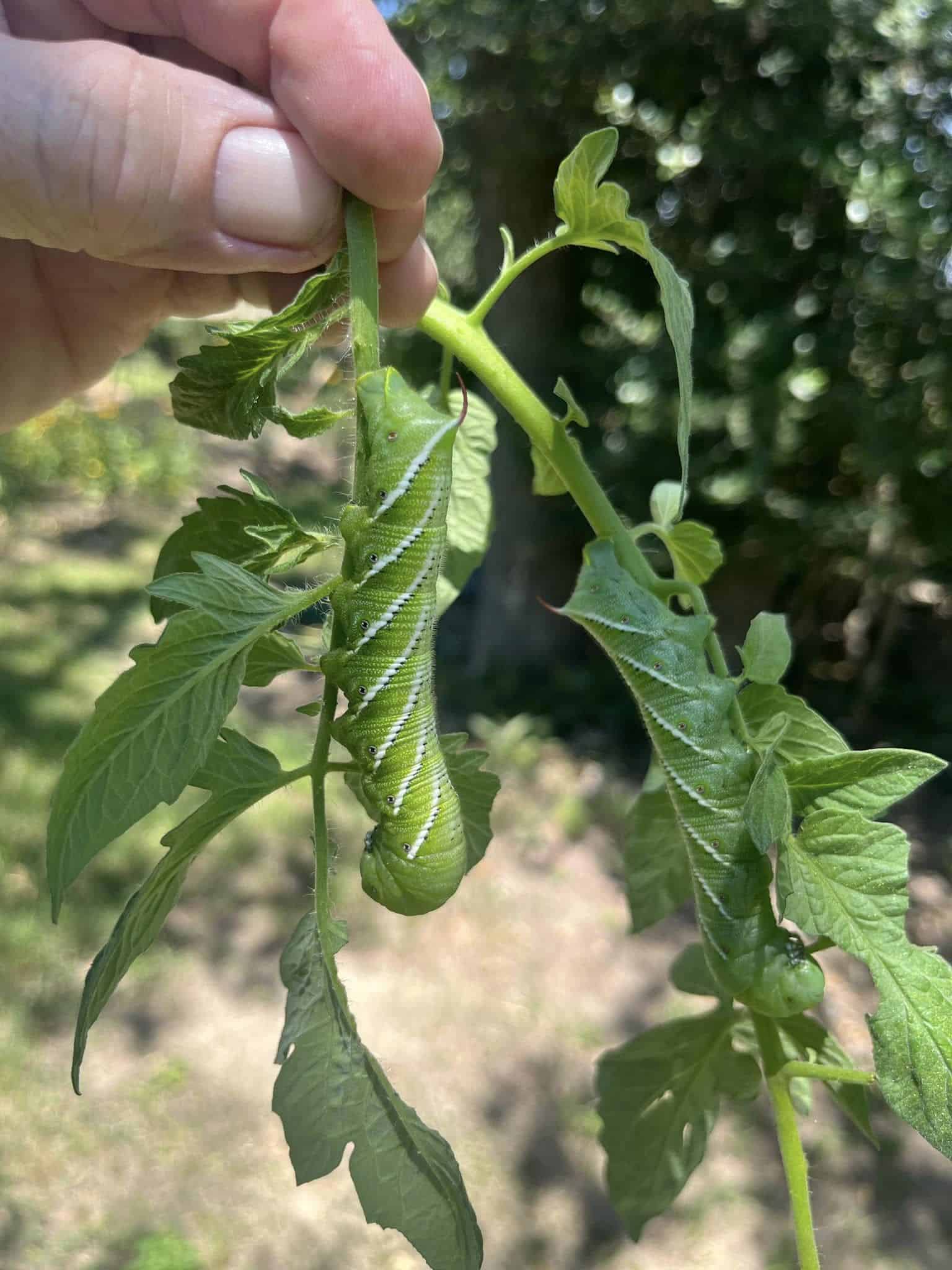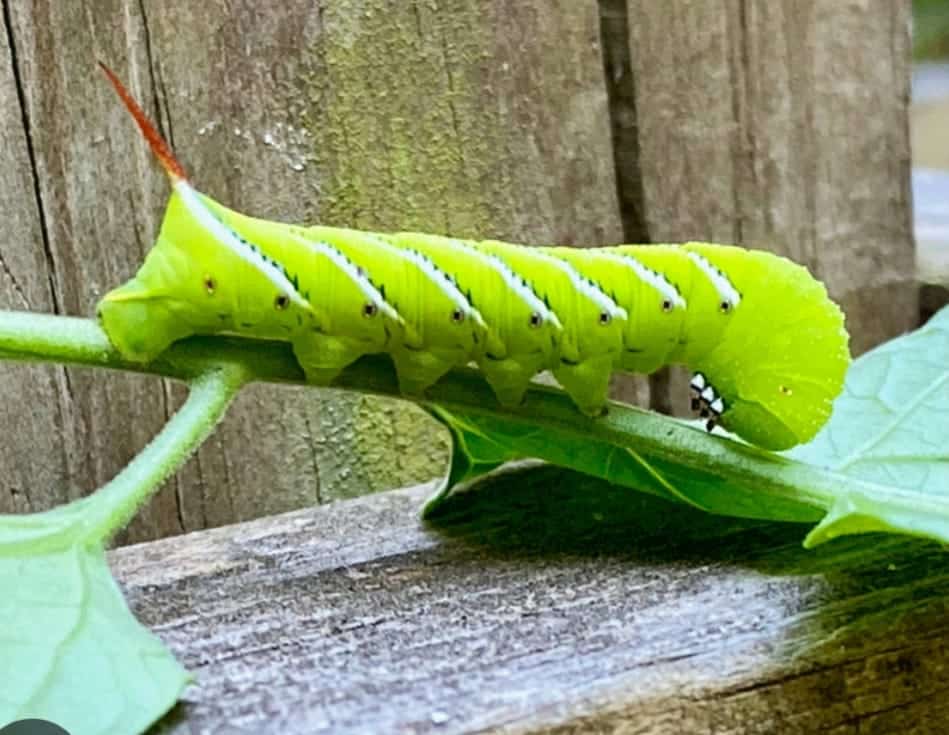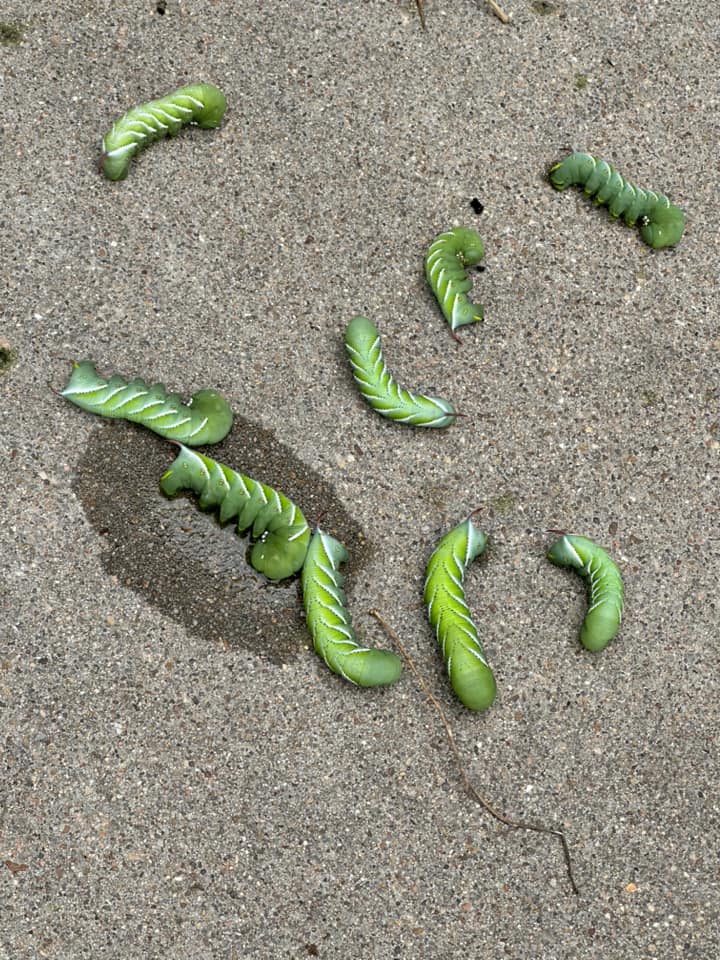Have you ever noticed strange-looking large green caterpillars with striking white stripes and a horn-like projection on their rear on your tomato plants? These are tomato hornworms.
These voracious pests can decimate tomato plants in a matter of days, leaving you frustrated and desperate for solutions. Based on this, killing them seems like the obvious course of action.
However, there’s an argument for letting them be because they host braconid wasps. Also, adult tomato hornworms are essential pollinators. So, should you kill tomato hornworms or not?
Keep reading as this piece delves into the arguments for and against eliminating tomato hornworms, aiming to provide a nuanced perspective.
Should You Kill Tomato Hornworms?
The question of whether to kill tomato hornworms or not requires looking at both sides of the argument. As mentioned above, there are valid arguments for preserving tomato hornworms and valid reasons for considering their removal, particularly if you want to protect your tomato plants.
Reasons to Kill Tomato Hornworms
1. Protect Your Tomatoes
The primary and most immediate reason for killing tomato hornworms is to protect tomato plants from these voracious feeders. A single tomato hornworm capable of stripping a tomato plant of its foliage in just a few days. This rapid defoliation can result in reduced photosynthesis, stunted growth, low fruit yield, and even death of young tomato plants.
Besides leaves, tomato hornworms chew on the fruits, leaving unsightly scars and making your tomatoes more susceptible to diseases and rot. This direct damage to the fruit further reduces the quality and quantity of the harvest.
2. Prevent Future Infestations
If you let tomato hornworms be, they will undergo different growth stages as they feed on your plants, eventually becoming moths that reproduce and lay eggs that hatch into new tomato hornworms. Killing them disrupts their life cycle, thus preventing future infestations.
Eliminate the hornworms in your garden during the growing season to lessen the number of overwintering pupae, thereby ensuring your garden won’t be marred by the same issue in the subsequent year.
Read More:
- How To Get Rid Of Mealybugs Naturally
- How To Get Rid Of Slugs And Snails In Garden
- How To Get Rid Of Ants In Garden Without Killing Plants
Reasons Not To Kill Tomato Hornworms
a) Natural Pest Control
Despite being pests, tomato hornworms can indirectly contribute to pest control. For instance, braconid wasps have parasitized hornworms with white cocoons on their backs.
These wasps lay eggs on the hornworms and consume the hornworm from the inside once the larvae hatch, thus killing the hornworm. Apart from destroying their host, they will kill other hornworms in your garden once they leave their cocoons.
The presence of tomato hornworms also attracts birds and predatory insects like praying mantises, predatory beetles, and spiders. These animals help control hornworms and other pests like caterpillars, beetles, and grasshoppers.
b) Pollination
Hawkmoths or sphinx moths, adult tomato hornworms are crucial pollinators for some plants with long-tubed flowers. Sphinx moths have long snouts that allow them to reach nectar deep within flowers that other pollinators cannot access.
These moths visit various flowering plants during the evening and nighttime. They are particularly effective in pollinating plants such as evening primroses, night-blooming jasmine, and certain species of orchids. These nocturnal pollinators complement the pollination work done by diurnal pollinators.
Note
So, should you kill tomato hornworms? Do not kill tomato hornworms with white cocoons on their backs. Instead, let them die on their own. They will attract beneficial insects, contribute to pollination, and get rid of other hornworms in the process.
How To Keep Hornworms Away From Tomato Plants
Considering the damage hornworms can cause to your tomato plants, keeping them away is in your best interests. Below are several ways to do so:
1) Grow Hornworm Repelling Plants
Lure hornworms away from your tomato plants by growing basil near them. This herb repels destructive pests like hornworms, aphids, and thrips. In addition, it is believed to enhance the tomato plants’ yield and the fruits’ flavor.
Borage also deters hornworms. Moreover, this herb produces bright-blue flower clusters that attract bees and other pollinators, which help improve tomato pollination. The other plants you can grow alongside your tomato plants to deter hornworms are marigolds and dill.
2) Handpicking
Regularly monitor your tomato plants for hornworms. Doing so makes it easier to control these pests before they damage your plants extensively. Start monitoring your tomato plants once they begin growing vigorously. Continue monitoring throughout the growing season, especially during peak moth activity periods in mid to late summer.
When inspecting your tomato plants, focus on the stems, growing tips, and leaf underside. Also, look for chewed leaves, missing foliage, and dark green or black droppings (frass) on the leaves and ground below the plants.
Remember that while the caterpillars are large, they can camouflage with the foliage. So, watch for damage to the plants as they indicate the presence of hornworms. You could use a magnifying glass or hand lens in order to spot small hornworms or their eggs more easily.
After spotting hornworms, pick them by hand and put them inside a bucket with soapy water to kill them. Alternatively, you can crush or feed them to birds if you have pet birds or chickens.
The best time to handpick hornworms is when these pests are active (this is typically in the morning or evening). Consider using a flashlight to get better visibility. After the initial hornworm removal, continue inspecting your tomato plants because they can quickly reappear.
Manual removal is straightforward, practical, and effective, especially for small gardens or when handling a few hornworms.
2) Grow Hornworm Repelling Plants
Lure hornworms away from your tomato plants by growing basil near them. This herb repels destructive pests like hornworms, aphids, and thrips. In addition, it is believed to enhance the tomato plants’ yield and the fruits’ flavor.
Borage also deters hornworms. Moreover, this herb produces bright-blue flower clusters that attract bees and other pollinators, which help improve tomato pollination. The other plants you can grow alongside your tomato plants to deter hornworms are marigolds and dill.
3) Apply Bacillus thuringiensis (Bt)
This soil bacterium occurs naturally and produces proteins toxic to some insects, including tomato hornworms. It is a highly effective, environmentally friendly method for controlling hornworms on tomato plants.
When hornworms ingest Bt, the bacterial proteins disrupt their digestive system, making them stop feeding and, in the end, die. Apply Bt at the first sign of hornworm activity or when you find small caterpillars on your tomato plants.
Evenly dust or spray Bt on all the surfaces of your tomato plants, including the tops and undersides of leaves, stems, and fruits. Bt is biodegradable, easy to apply, and explicitly targets caterpillars, hence harmless to beneficial insects, pollinators, humans, and animals.
4. Spray Neem Oil
This natural insecticide can also help keep hornworms from your tomato plants as it disrupts their feeding and growth. Get a cold-pressed, pure neem oil or a commercial neem oil-based insecticide labeled for use on vegetables, dilute it, and spray the solution evenly all over your tomato plants.
5. Garlic and Chili Spray
A homemade garlic and chili spray repels hornworms. Garlic’s strong smell and the capsaicin in chili peppers naturally deter many pests, including hornworms. This spray is safe for humans, pets, and beneficial insects, provided you use it properly.
Blend and strain chili peppers and garlic cloves with water and thoroughly spray it on your tomato plants.
6. Insecticidal Soap
While safe for humans, pets, and most beneficial insects, insecticidal soaps kill soft-bodied insects by penetrating their outer shells, causing dehydration and death. You can buy a commercial insecticidal soap or make your own by mixing 2.5 tablespoons of pure liquid soap (like Castile soap) with 1 gallon of water.
7. Create Physical Barriers
Prevent hornworms from getting to your tomato plants by placing lightweight row covers over the plants. These covers effectively keep hornworms and other pests out while allowing light, water, and air to reach the plants.
You can also place metal, plastic, or cardboard-made cylinders around the base of young tomato plants to keep hornworms from reaching the stem and lower leaves. Moreover, you can protect tomato plants from hornworms using fine mesh or netting.
8. Till The Soil
Despite your best efforts at getting rid of hornworms, some caterpillars can get away, developing long enough to mature. Adult tomato hornworms drop to the soil and burrow 4-6 inches deep pupation chambers, where a new generation of adult moths will emerge.
Pupation can occur twice during the growing season, with the first-generation moths emerging in mid-summer and the second in spring from overwintering pupae. You can wipe out overwintering pupae and keep them from surviving to spring by tilling the soil in the fall.
Conclusion
The impulse to kill tomato hornworms to protect your tomato plants and preserve your garden’s beauty is understandable and often necessary. However, it would help if you left alone hornworms with grain-looking protrusions on their back. If these hornworms complete their life cycle, the parasitic wasps will help keep the hornworm populations in your garden in check.

I’m Mike Hyle, an exterminator with 7+ years of experience handling all sorts of pests, including mice, cockroaches, bed bugs, and termites. I also write for Pest Solutions DIY blog to share my knowledge and help homeowners keep their homes pest-free. Outside work, I enjoy hunting, snowshoeing, and exploring nature. Check out my blog for helpful pest control tips!



